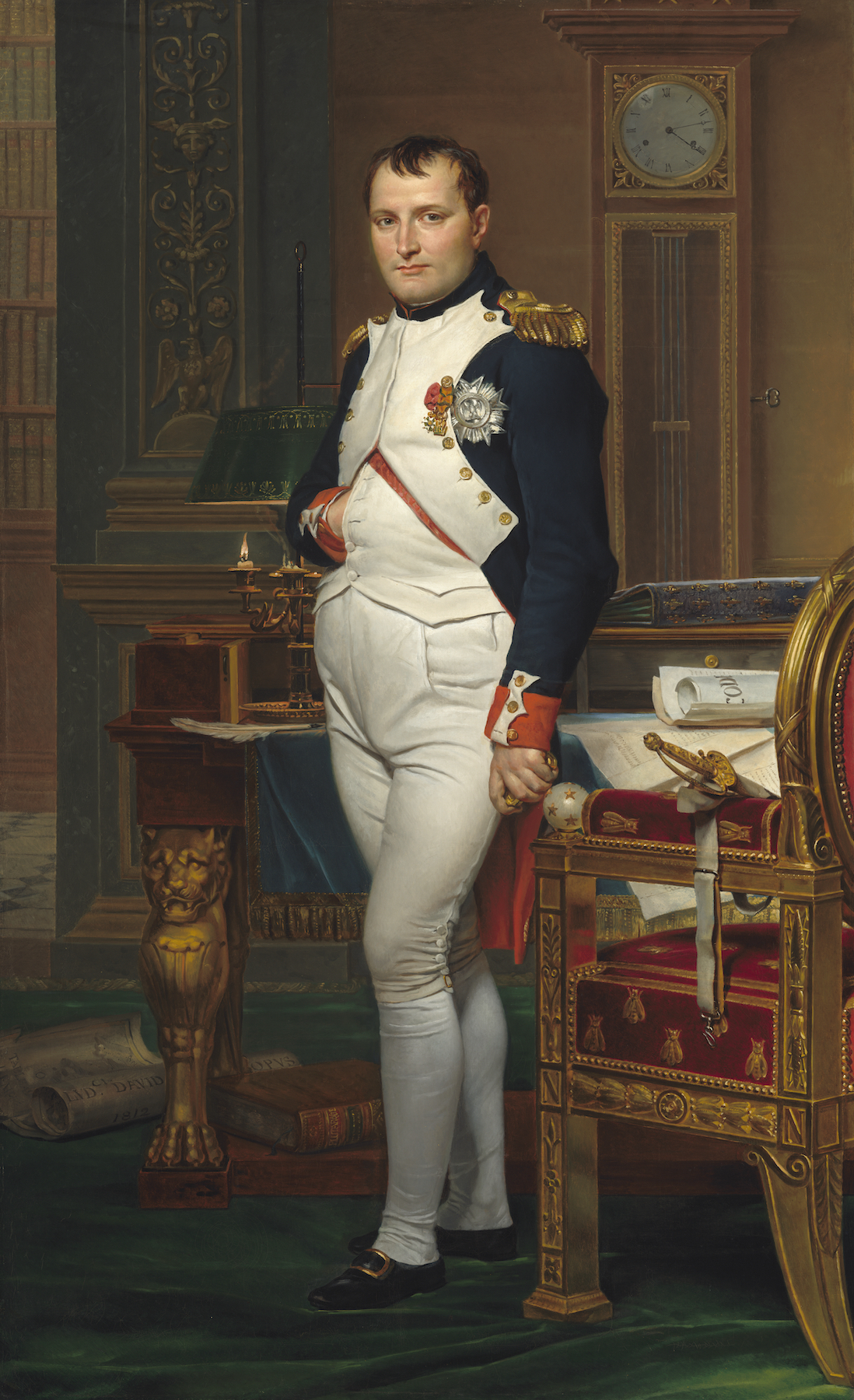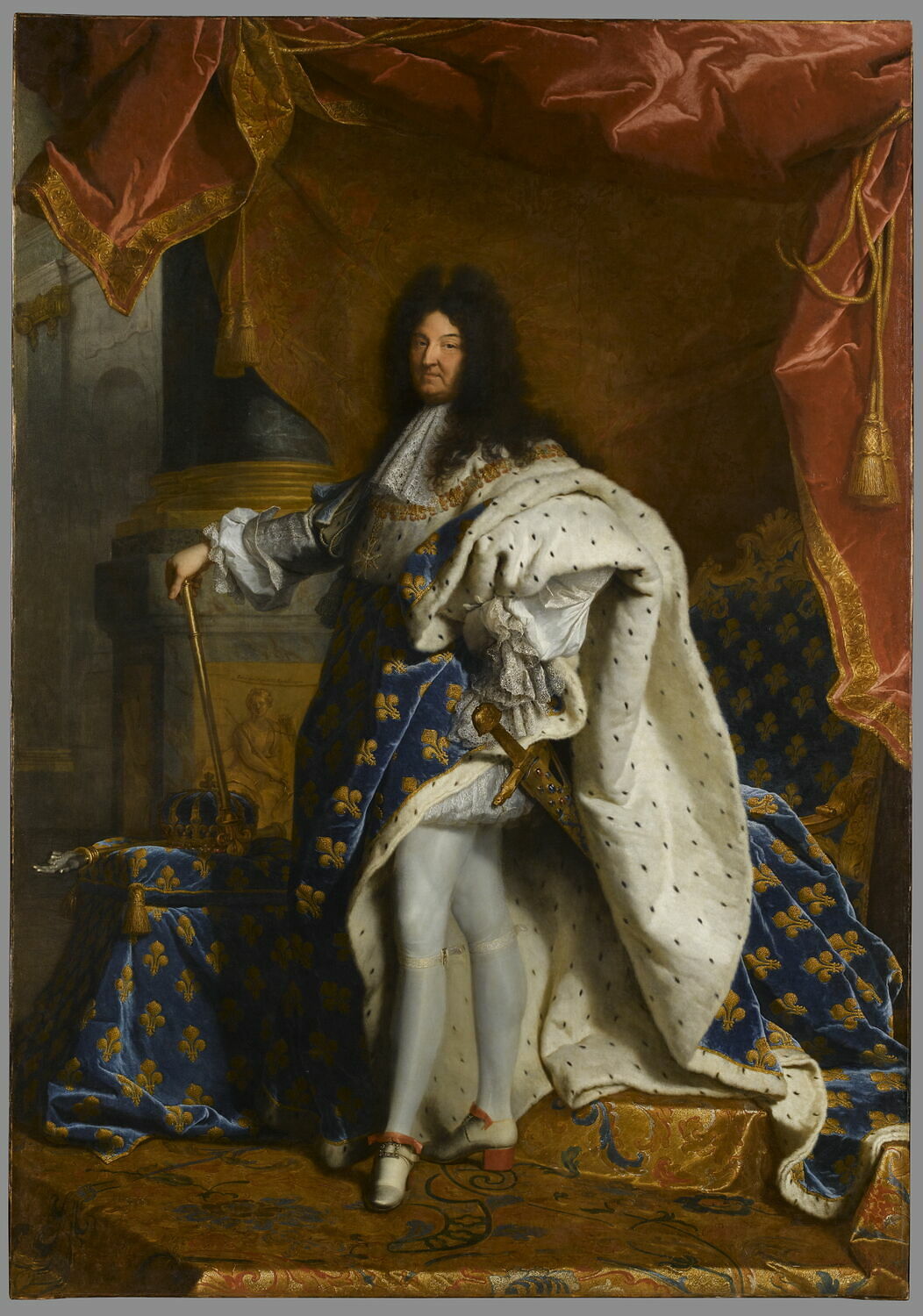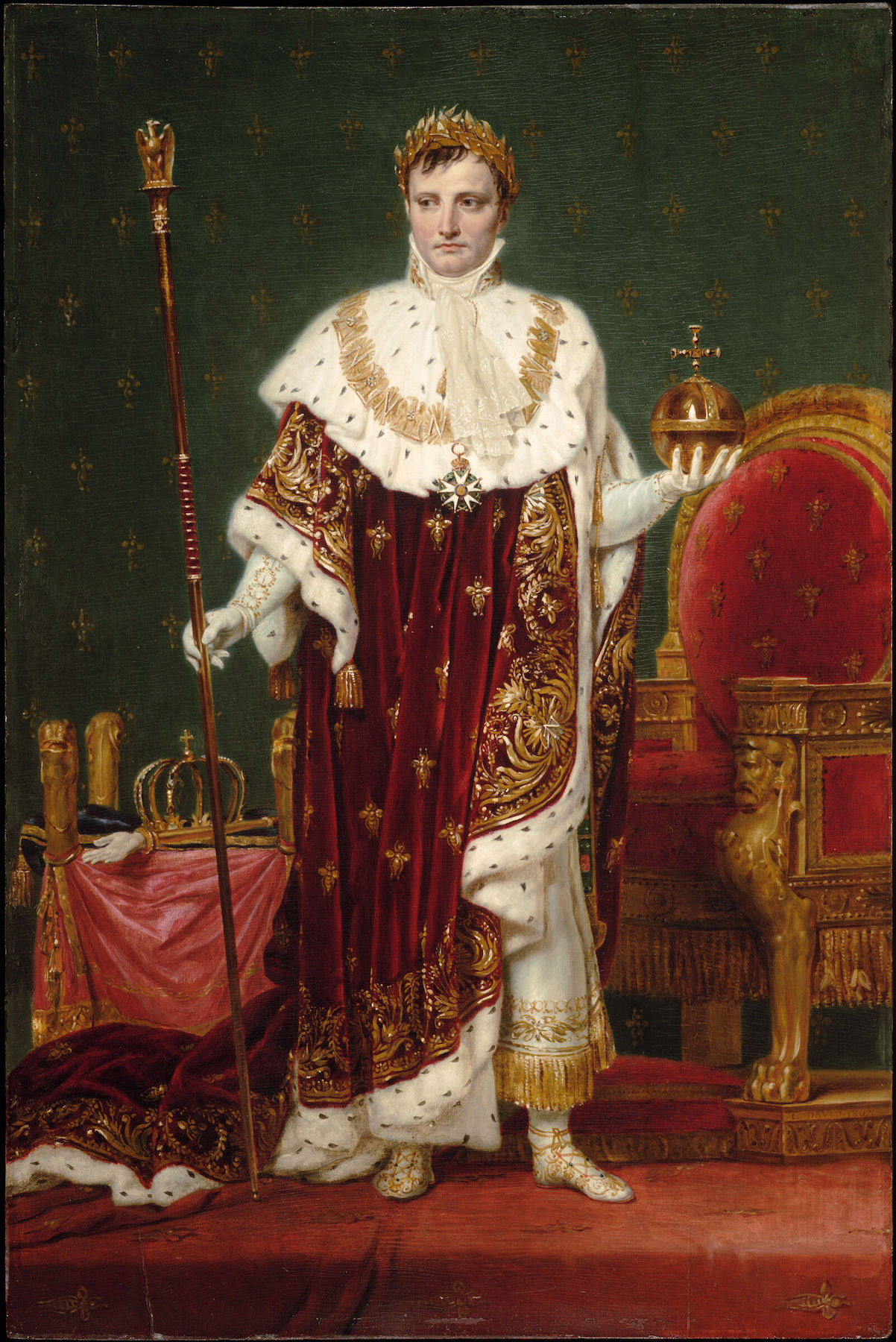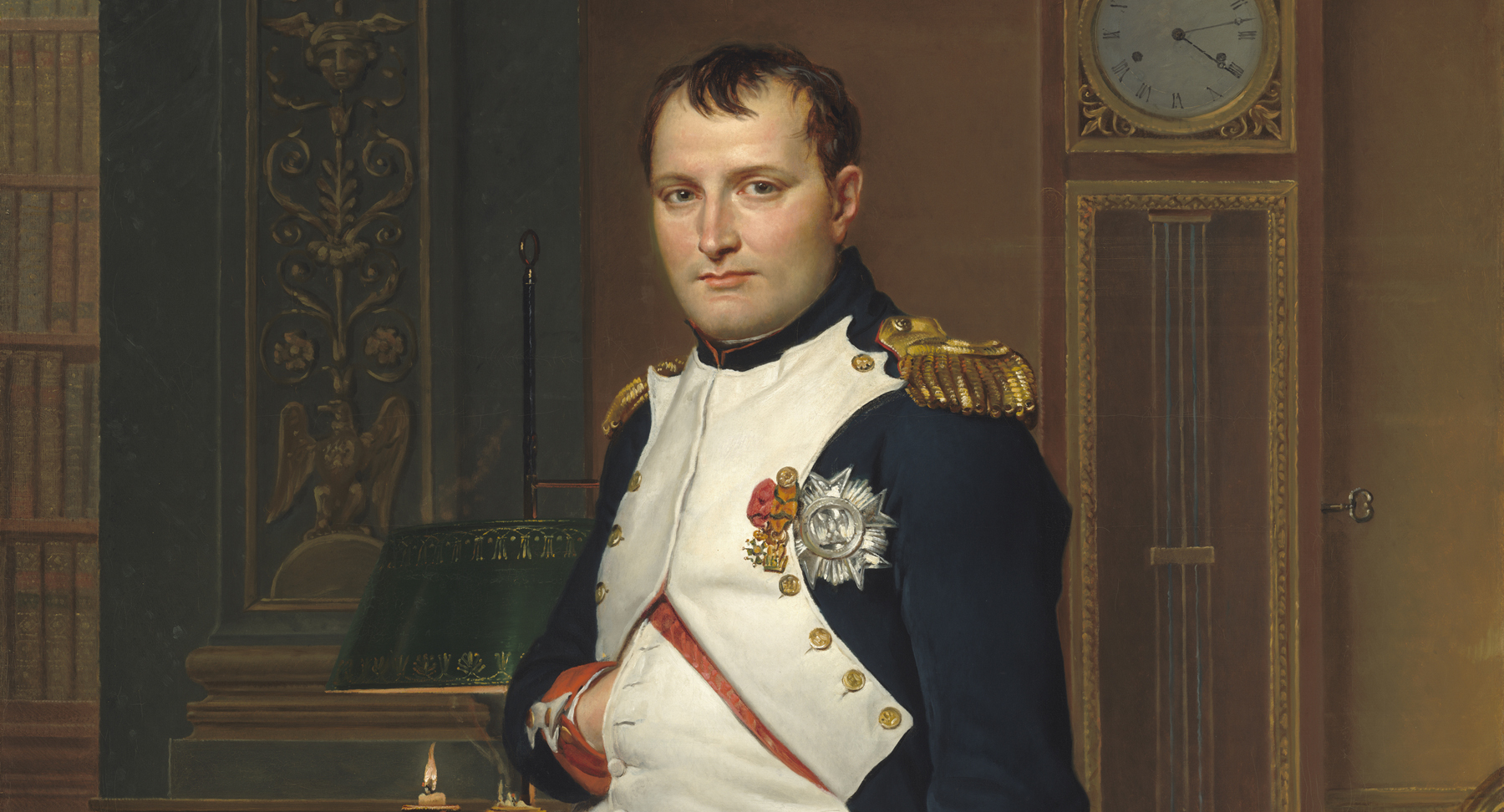Jacques-Louis David was the leading portraitist of his day in France. He was known for his ability to capture the likeness of his sitters. But he was even more skilled at communicating the personalities and accomplishments of his subjects.
The Emperor Napoleon in His Study in the Tuileries is one of the ultimate examples. David filled the portrait with precise details, portraying Napoleon as a living legend.
Take a scroll with us through the painting and see how Napoleon’s appearance, the setting, and the items create a myth of an ideal leader. See if you can spot David’s signature hidden in the painting.

Jacques-Louis David, The Emperor Napoleon in His Study at the Tuileries, 1812, oil on canvas, Samuel H. Kress Collection, 1961.9.15
Napoleon, the man of the people
The full-length portrait shows Napoleon standing in his study at the Tuileries Palace, his official Parisian residence.
-
The clock behind him shows the time—4:13. Details suggest that this hour is in the early morning.
/
-
On Napoleon’s other side, a candelabra lights his desk. The candles are nearly burnt out.
/
-
Napoleon looks tired and disheveled.
/
-
His hair is out of place. He has bags under his eyes.
/
-
His stockings are rumpled. What has kept him up so late?
/
-
A clue rests on his desk—a curling sheet of paper shows the letters “COD.”
/
This suggests that Napoleon has been working late on the Napoleonic Code, France’s first code of civil laws. It created a unified set of laws for the entire country. David shows Napoleon as a dedicated legislator, working all night on behalf of the people. But the achievement he is working on dates to a decade earlier.
The code was written between 1801 and 1803, and entered into force in 1804, before Napoleon crowned himself emperor later that year. And while the code did abolish privileges based on birth and the feudal system, it did not serve all the people. Women actually lost rights—the laws established them as lesser than their fathers and husbands.
David’s choice to paint the ruler at work was unconventional to begin with. Most royal portraits show kings just being. Dressed in their finest and set in splendor, they embody the state. In earlier portraits of Napoleon, David had followed that tradition.

Hyacinthe Riguad, Louis XIV (1638-1715), roi de France, 1701, Louvre Museum

Jacques-Louis David, Emperor Napoleon I, oil on panel Harvard Art Museums/Fogg Museum, Bequest of Grenville L. Winthrop. Photo © President and Fellows of Harvard College
Napoleon, the military leader
No portrait of Napoleon could be complete without a reference to his military background. David had first won the emperor’s favor with a dramatic portrait of him astride a rearing horse, Napoleon Crossing the Alps.
-
Here, Napoleon wears his uniform. He was a colonel of the Foot Grenadiers of the Imperial Guard.
/
-
On his shoulders are a general’s gold epaulettes.
Stars on his chest represent ranks in the Legion of Honor and Iron Crown of Italy.
/
-
We can see the ornate golden handle of a sword resting on the arm of the chair in front of him. The dangling white leather strap suggests that he is about to put it on.
/
-
A map tossed on the floor next to the desk alludes to Napoleon’s military strategy.
/
-
Plutarch’s Parallel Lives sits askew on the base of the desk.
The Greek philosopher’s biographies of famous Greek and Roman men would have inspired Napoleon.
/
-
Is David casting Napoleon as the modern-day Alexander the Great or Julius Ceasar?
/
-
Napoleon places one hand in his vest.
/
-
The pose was meant to show him as a measured and even-tempered leader.
/
-
An 18th-century etiquette book described it as signifying “manly boldness tempered with modesty.”
/
In reality, “tempered” was not a word many would have used to describe Napoleon. He was known for outbursts. And his desire for power and influence seemed to drive his quest to conquer Europe and create a French empire. His risky and unnecessary military campaigns led many French soldiers to their deaths.
The same year this painting was completed, Napoleon directed an invasion of Russia that would be a massive failure. Five months of battle killed Approximately 1 million French and Russian soldiers and civilians.
Napoleon, the trendsetter
After completing this portrait, David wrote in a letter, “I have made sure that everything in the picture, down to the smallest detail of costume, furniture, sword, etc., was scrupulously modelled on [Napoleon’s] own.”
While it may be true that all of these were real items, not all would have been found in Napoleon’s study. But David included them to help establish Napoleon as the creator of a new style.
Fine decorative arts were important to Napoleon. He believed they could serve to promote the glory of France. He encouraged a neoclassical style with references to ancient Greek and Roman motifs. It also incorporated Egyptian designs inspired by his campaign in the Ottoman territory. Today, this is known as Empire style.
Napoleon didn’t just encourage borrowing styles from ancient art. He also pillaged and stole works from around the globe. His troops often brought souvenirs back to France from military campaigns. These irreplaceable cultural artifacts filled the Louvre Museum in Paris, renamed the Musée Napoléon during his reign. After Napoleon was removed from power, many works were returned. But several remain on view today, including the iconic Vénus de Milo sculpture and Paolo Veronese’s The Wedding Feast at Cana.
-
Napoleon stands behind a lavish red velvet and gold throne.
/
-
David would have been very familiar with this chair—he designed it.
/
-
It features the emperor’s chosen emblem, the bee. The insect had long been used to represent industriousness.
The “N” insignia (for Napoleon) was also used liberally on his furniture.
/
-
The stars on the arms of the chair were another one of Napoleon’s imperial symbols.
/
But a throne wouldn’t be used at a desk. Its placement here is symbolic.
How do portraits influence the way we see historic figures? David uses realism and careful details to create a powerful myth of Napoleon as a military leader and lawgiver. But it’s not the full story. In spite of David’s convincing painting, we must reckon with Napoleon’s complicated legacy.
